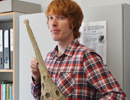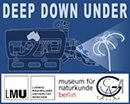Past Projects
Alexander von Humboldt-funded project of Thodoris Argyriou: Illuminating the early evolutionary history and cranial eco-morphology of neopterygian fishes
 Over 99% of living ray-finned fish species are part of the so-called neopterygian clade, which is estimated to have arisen in the late Paleozoic (~350 million years ago). The overarching goal of this project is to provide a wealth of novel anatomical information for reconstructing the early neopterygian portion of the tree of life.
Over 99% of living ray-finned fish species are part of the so-called neopterygian clade, which is estimated to have arisen in the late Paleozoic (~350 million years ago). The overarching goal of this project is to provide a wealth of novel anatomical information for reconstructing the early neopterygian portion of the tree of life.
Contact person: Dr. Thodoris Argyriou
Marie Skłodowska-Curie Innovative Training Network IGNITE.

IGNITE’s overarching research goals are to improve the sampling and analysis of invertebrate genomes, especially from undersampled branches of the animal tree of life, and to extend the toolbox for their analysis, including the development and deployment of innovative production-level software beyond the current state-of-the-art.
IGNITE’s core training objectives are:
- to convey broad interdisciplinary knowledge in organismal biology, animal physiology, ecology, biogeography, evolution, and genomics;
- to provide the technical laboratory skills required for genomics;
- to impart technical computing skills in programming and bioinformatic pipeline development;
- to build experience in effective dissemination and communication of results to target audiences; and
- to provide young researchers with a unique set of relevant academic and non-academic transferable skills to enhance human resource development and entrepreneurship; and
- to establish a strong and long-lasting European and international network in invertebrate genomics [more info].
Contact person: Prof. Dr. Gert Wörheide
“Dawn of the Dinosaurs: Archosauromorph Evolution in the Terrestrial Triassic”
 Dr. Richard Butler gained his Ph.D in 2007 from the University of Cambridge and has since worked as a researcher at the Natural History Museum (London) and the Bayerische Staatssammlung für Paläontologie und Geologie. His DFG Emmy Noether Junior Research Group will focused on the early evolutionary radiation and rise to ecological dominance during the Triassic (250–200 million years ago) of Archosauromorpha, a major group of vertebrates that include birds, crocodiles, dinosaurs and pterosaurs. They will also examine the impact of the major mass extinctions at the Permian/Triassic and Triassic/Jurassic boundaries in driving this radiation. The research team consisted of Dr. Butler and two Ph.D students, and used cutting edge morphological and analytical approaches, such as microCT scanning and web-based morphological databases, to address outstanding taxonomic and phylogenetic questions. Moreover, the team used quantitative techniques to analyse and model macroevolutionary and biogeographical patterns, including changes in taxonomic and morphological diversity and body size evolution. This research program will involved collaborations with researchers in Europe, the USA, South America, China and Russia, and will be linked with an ongoing field program co-led by Dr. Butler in the Triassic of Portugal.
Dr. Richard Butler gained his Ph.D in 2007 from the University of Cambridge and has since worked as a researcher at the Natural History Museum (London) and the Bayerische Staatssammlung für Paläontologie und Geologie. His DFG Emmy Noether Junior Research Group will focused on the early evolutionary radiation and rise to ecological dominance during the Triassic (250–200 million years ago) of Archosauromorpha, a major group of vertebrates that include birds, crocodiles, dinosaurs and pterosaurs. They will also examine the impact of the major mass extinctions at the Permian/Triassic and Triassic/Jurassic boundaries in driving this radiation. The research team consisted of Dr. Butler and two Ph.D students, and used cutting edge morphological and analytical approaches, such as microCT scanning and web-based morphological databases, to address outstanding taxonomic and phylogenetic questions. Moreover, the team used quantitative techniques to analyse and model macroevolutionary and biogeographical patterns, including changes in taxonomic and morphological diversity and body size evolution. This research program will involved collaborations with researchers in Europe, the USA, South America, China and Russia, and will be linked with an ongoing field program co-led by Dr. Butler in the Triassic of Portugal.
Contact person: Dr. Richard Butler
Deep Down Under
 In close collaboration with Project Deep Ocean Australia & the Queensland Museum (Brisbane, Australia) Exploration of relict faunas at Osprey- and Shark Reefs (Queensland Plateau, Coral Sea, Australia). An exceptional sessile invertebrate fauna was discovered in the 1970s on the Norfolk Ridge in the SW Pacific. This fauna is remarkable because it contains populations of animals that were previously thought to be extinct but have persisted almost unchanged on the deep reef slopes since the late Mesozoic (>65 MYA). [more info]
In close collaboration with Project Deep Ocean Australia & the Queensland Museum (Brisbane, Australia) Exploration of relict faunas at Osprey- and Shark Reefs (Queensland Plateau, Coral Sea, Australia). An exceptional sessile invertebrate fauna was discovered in the 1970s on the Norfolk Ridge in the SW Pacific. This fauna is remarkable because it contains populations of animals that were previously thought to be extinct but have persisted almost unchanged on the deep reef slopes since the late Mesozoic (>65 MYA). [more info]
Contact person: Prof. Dr. Gert Wörheide
FORRSA - Forest restoration and rehabilitation in Southeast Asia
 The project aimed at the human capacity enhancement of Asian and European young academics and postgraduate students for teaching and research on restoration and rehabilitation of degraded forests and wetlands in Southeast Asia, specifically Indonesia and Thailand. The special emphasis is on the use of multi-criteria analysis/decision making by integrating GIS methods and tools with ecological and social knowledge. [more info]
The project aimed at the human capacity enhancement of Asian and European young academics and postgraduate students for teaching and research on restoration and rehabilitation of degraded forests and wetlands in Southeast Asia, specifically Indonesia and Thailand. The special emphasis is on the use of multi-criteria analysis/decision making by integrating GIS methods and tools with ecological and social knowledge. [more info]
Contact person: Prof. Dr. Florian Siegert
Restorpeat
The project aimed at research and development of new methods on the sustainable restoration of disturbed tropical peatlands and peat swamp forest ecosystems. The implementation will involve a range of measures including blocking of channels and drains, restoration of hydrology and ecological functions, rehabilitation of peat swamp forest and its biodiversity, identification of alternative funding mechanisms to promote sustainable livelihoods and formulation of guidelines for sustainable agriculture and forestry. [more info]
Contact person: Prof. Dr. Florian Siegert
Environmental structure and food webs of the northern Chilean Fjord systems
In cooperation with the research station ‚Huinay’ of the Chilean Fundacion Huinay three members of the GeoBio-CenterLMU (GBC) spent two months in Huinay/Chile in early 2007. The excursion was in preparation for a larger project towards investigation of environmental structure and food webs of the northern Chilean Fjord systems. [more info]

